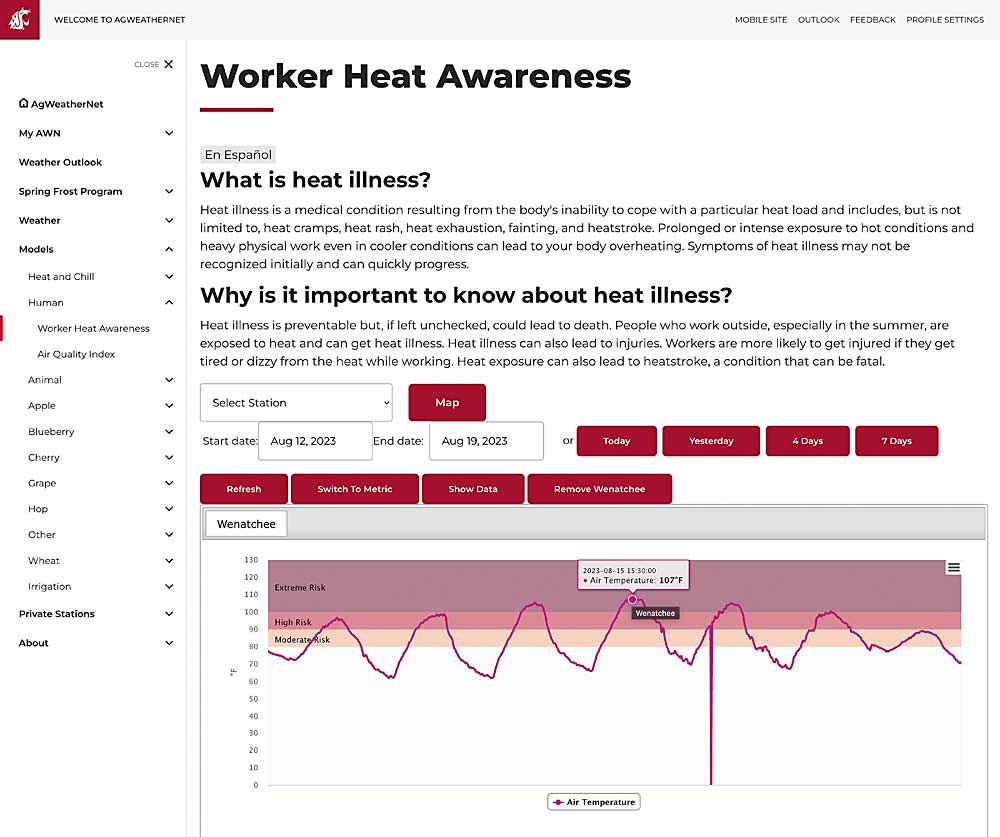[ad_1]
—by Kate Prengaman

Crops aren’t the one issues in danger from warmth stress and wildfire smoke within the air. So are the individuals who work to reap them.
New fashions on Washington State College’s AgWeatherNet web site provide growers a one-stop store for the climate knowledge they should make selections to guard their crops and their workers underneath Washington’s warmth and smoke guidelines. The principles took impact in 2023.
Deploying the prevailing community of climate sensors — together with the grower-owned stations — and the prevailing alert system used for frost occasions can assist growers adjust to the warmth security guidelines, mentioned Lav Khot, director of AgWeatherNet. In the meantime, a brand new set of sensors put in at key stations tracks smoke air pollution.
“If you’re in search of data on air high quality, we now have that choice,” Khot mentioned.
His group has been putting in sensors on dozens of its stations in rural areas to trace the tiny air air pollution particles that pose the well being threat in wildfire smoke. They’re supported partly by the Washington State Division of Labor and Industries and are working with the College of Washington’s Pacific Northwest Agricultural Security and Well being Heart, or PNASH, to develop fashions that can interpret smoke and warmth knowledge.
The pre-existing air high quality sensor community centered on higher-population areas, and a 2020 survey discovered simply 35 complete sensors throughout Japanese Washington, mentioned Eddie Kasner, outreach director for PNASH.
“The state has added monitoring websites, however the variety of established AWN websites surpasses that and are positioned nearer to agricultural worksites,” he mentioned in an e-mail interview.
Wildfire-caused air air pollution may be fairly variable throughout the panorama, so native sensors can assist growers make higher selections for crops impacted by wildfire smoke, corresponding to wine grapes, and for employee security, Khot mentioned.
Whereas smoke and warmth are handled as two separate employee issues of safety underneath Washington laws and AgWeatherNet fashions, PNASH analysis exhibits that the dangers compound throughout July, August and September.
“The dangers of antagonistic well being results from each warmth and wildfire smoke in agriculture are influenced by components that embody: extra work outside throughout the summer season in areas liable to wildfire smoke; elevated cardiorespiratory and metabolic calls for of labor; restricted choices for work duties throughout smoke and warmth occasions; and extra exposures exterior of labor,” Kasner mentioned.
Along with offering employers air high quality knowledge, the sensors’ knowledge can even assist PNASH’s ongoing analysis into smoke forecasting, which goals to reveal if lower-cost, native sensors put in in partnership with AgWeatherNet can present higher air high quality forecasts than conventional regulatory screens.
“We are going to proceed partnering with growers to grasp their wants, present proof-of-concept for wildfire smoke knowledge in farm administration selections, and set up a regional smoke-sensing community designed for agricultural communities,” Kasner mentioned.
To seek out the employee security fashions on the AgWeatherNet platform, choose the “Human” tab discovered underneath the “Fashions” menu, alongside apple, cherry, blueberry and hop choices. Each the warmth and smoke pages embody hyperlinks to further assets from PNASH. Alerts may be arrange underneath the “My AWN” tab.
For extra assets, head to PNASH’s web site for its Warmth Sickness Toolkit at: bit.ly/heat-illness-toolkit and wildfire smoke security webpage at: bit.ly/wildfire-smoke-safety. Each websites provide assets in English and Spanish. •
[ad_2]

